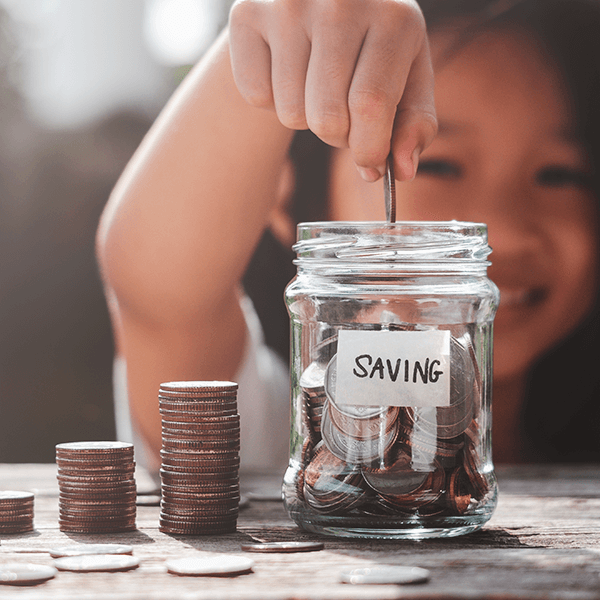Junior ISAs vs child savings accounts
Junior ISAs and child savings accounts both exist to help you save for your child’s future, but they suit different needs.
Article at a glance
| Junior ISA | Child savings account | |
|---|---|---|
| What kind of account is it? | Cash or stocks and shares (stocks and shares for a OneFamily Junior ISA). | Cash. |
| Who can access the money? | Only the child and only when they turn 18. | The person who opened the account and the child (from the age of seven). |
| Is there any tax to pay? | No. | There could be some tax to pay if the returns go over a certain amount. |
| Who can open the account? | Only a parent or legal guardian. | Anyone. |
| Who can pay in? | Anyone. | Anyone. |
| What is it best for? | Long-term savings for a child. | Teaching your child how to save and manage their money. |
What are junior ISAs?
Junior ISAs (JISAs) are savings account for children. They can be opened by a parent or legal guardian for a child aged 17 years old or younger. Children must be under 16 to be eligible for a OneFamily Junior ISA.
Anyone can pay into a JISA but the money is locked in for the child until they turn 18. You can’t open a JISA for a child who already has a Child Trust Fund, but you can transfer a Child Trust Fund into a junior ISA.
There are two types of JISA: cash and stocks and shares.
- Cash junior ISAs
A cash JISA is a type of savings account for a child. They grow by building interest, like current accounts, and aren’t invested in stocks or assets. This means they’re protected from changes in the stock market, but if cost-of-living goes up the money you put in now might not be worth as much in the future.
- Stocks and shares junior ISAs
A stocks and shares JISA is an investment account for a child. Money that is paid in is invested in the stock market, so it has good potential to grow over the long-term. It’s worth being aware that the value of stocks can go up or down so your child could get back less money than has been put in.
What are child savings accounts?
Child savings accounts are exactly what they sound like: savings accounts for children. They can be opened with banks or building societies. They’re simple cash accounts that grow by building interest. You can open a savings account for any child up to 18 years old with £1.
Child savings accounts are mostly designed to help you teach your child about saving and money management. The money can be accessed at any time.
There are three types of child savings accounts: easy access, instant access and regular.
- Easy-access and instant-access child savings accounts
Easy-access and instant-access child savings accounts are very similar. Both types of account let you or your child put money in or take money out at any time. With instant-access accounts you can do this straightaway, for example by taking money out of a cash machine. It can take slightly longer to take money out of an easy-access account, but it’s still easier to get your hands on the money than it is with a regular child savings account.
However, make sure you check the rules on the account as some providers may limit how many times you can take money out or offer lower interest rates if you do so often.
These types of accounts tend to have lower interest rates overall than regular savings accounts.
- Regular child savings accounts
Regular child savings accounts are geared towards more regular saving. You have to deposit money into the account at least once a month and it may take longer to withdraw from than an easy-access child savings account. They usually have a higher interest rate than easy-access child savings accounts, but if you miss some of your monthly payments the interest rate could go down.
What are the similarities between junior ISAs and child savings accounts?
Both JISAs and child savings accounts are designed to help you save for your child. They both have a low opening deposits - you can open a OneFamily JISA with as little as £10 and a child savings account with £1.
What are the differences between junior ISAs and child savings accounts?
| Junior ISAs | Child savings accounts | |
|---|---|---|
| What's the minimum investment? | £10 (for OneFamily Junior ISAs, other junior ISA providers have different minimum investments) | £1 |
| What are the age limits on the account? | You can open a junior ISA for children from birth up to the age of 18 (OneFamily Junior ISAs can be opened up to the age of 16). | Child savings accounts can be opened for children from birth up to the age of 18. |
| How much can you pay in? | Up to £9,000 each tax year. | There is no limit. |
| Who can open the account? | Only someone with parental responsibility (the child's parent or legal guardian). | Anyone. |
| Who can pay money in? | Anyone. | Anyone. |
| Who can take money out? | Only the child and only when they turn 18. | The person who opened the account can withdraw money at any time. The child themselves can take money out from the age of seven. |
| Do we need to pay tax on the interest or returns? | No. | Parents should inform HMRC if their child makes more than £100 in interest during a tax year. They will only have to pay tax however if this takes them over their Personal Savings Allowance. |
| How is the account managed? | The parent or legal guardian who opened the account manages it until the child can take control at 16. | The child can manage their own account, along with the person who opened it, from the age of seven. |
Can a child have a junior ISA and a child savings account?
Yes. Since they have different savings goals, they can pair well together. You could open a JISA for your child to help in the long-term while also opening a child savings account to teach them about the importance of saving and managing money. That way, when they gain access to the amount in their JISA at 18, they’ll be better equipped to deal with it responsibly.
What’s the best way to save for my grandchildren?
If you want your grandchild to access the money you save when they turn 18, a JISA could be a good option. Grandparents can’t open a JISA for a child (unless they are their legal guardian) but they can pay into one.
Ask your grandchild’s parents if they’ve opened a JISA for them, and use this as an opportunity to agree on how much you can each contribute to the account to avoid going over the annual limit.
JISAs are also helpful when it comes to inheritance tax.
Grandparents can open a child savings account but the child may be able to take the money out whenever they want, depending on the account.
What type of account should I open for my child?
Your child can have a cash JISA, a stocks and shares JISA, a child savings account and even a Junior Bond at the same time. Different types of accounts are better for different purposes and situations.
Junior ISAs are geared towards long-term saving and giving your child a boost when they turn 18.
Since no-one can take the money out before then, they’re a better option if you want to build up a lump sum that your child can then use to help them get a head start in their adult life.
This could mean moving the money into a different product, such as a lifetime ISA or adult ISA, buying their first car or going to university.
Child savings accounts are easier to withdraw from, as the money isn’t locked in for the child.
Since your child can manage their own account from a young age, they’re a good option to teach them about the importance of savings and managing their money.
Rather than using them for long-term saving, child savings accounts could be useful to help your child save up their pocket money and gift money so they can spend it on larger purchases later on.
Ultimately, the type of account you open for your child is up to you.
While the money in a JISA is locked in for the child until they turn 18, the money in a child savings account isn’t. This gives JISAs an advantage when it comes to long-term savings, while child savings accounts can be really useful to give your child their first taste of savings and teach them useful money management skills for the future.

Our OneFamily Junior ISA
With our stocks and shares Junior ISA you can start investing from just £10 per month up to a maximum of £9,000 each year on behalf of a child. Anyone can pay in, and the child will gain access to the account once they are 18 years old.
Stocks and shares JISAs have good long-term growth potential, but the value of your investments can go up or down and your child could get back less money than you’ve put in.

Find out about junior ISAs
What would you like to do next?
Start saving today
Your kids deserve a head start. Invest in your children's future with our stocks and shares Junior ISA for tax-free savings
Transfer a child trust fund or junior ISA
Transferring a child trust fund or junior ISA from another provider to OneFamily is simple and we don't charge you to do so.
Learn more about junior ISAs
Find out more about how a JISA can help you save for your child's future.
